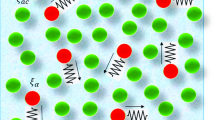Abstract
An analysis of nonequilibrium phenomena behind a plane shock is presented concerning the vibrational relaxation and the dissociation of a pure diatomic gas. In the first part, the temperature range is 600 K–2500 K and the dissociation processes are neglected. The population of each vibrational level is computed by solving relaxation and conservation equations. The relaxation process is described by the master equations of each vibrational level. The vibrational transition probabilities appearing in the relaxation equations are calculated analytically and take into account the anharmonicity of molecular vibration and the potential angular dependence. The populations obtained are compared to those calculated using a Treanor model and to those calculated with a nonequilibrium Boltzmann distribution. For moderately high levels significant differences may be observed. The importance of the V-V process is found to be weak for the transitions involving the lowest levels. In the second part, the temperature range is 2500 K–5500K and the dissociation process is taken into account as well as the gas dynamic behavior which did not appear in several recent works. The kinetic equations are transformed to obtain a first order differential system and the resolution of such a system coupled with the conservation equations leads to the population of each vibrational level. The vibrational transition probabilities associated with the atom-molecule interaction are deduced from the cross section calculation used in the first part. The bound-free transition probabilities are obtained, following Marrone and Treanor, assuming that dissociation must occur preferentially from the higher vibrational states: the Marrone and Treanor probability model is extended and employed with an anharmonic oscillator. In the present investigation, behind the shock wave, the evolution of the population distribution expressed as a function of the distance is not monotonous: a lag time appears as shown experimentally in previous works for the macroscopic parameters. For moderately high levels the influence of the anharmonicity and those of the V-V processes appear significant and strongly related. In a general way, in both temperature ranges investigated, the V-V processes reduce the effects of the T-V transfer. Finally the influence of the“characteristic probability temperature” U of Marrone and Treanor is analyzed and a method of determination of local varying U is proposed.
Similar content being viewed by others
References
Breshears WD, Bird PF, Kiefer JH (1971) Density gradient measurements of 02 dissociation in shock waves. J Chem Phys 55:4017–4026
Brun R, Zappoli B (1977) Model equations for a vibrationally relaxing gas. Phys Fluids 20:1441–1448
Brun R (1986) Transport et Relaxation dans les Ecoulements Gazeux Chap. 1, 2, 3, Masson, Paris
Camac M (1961) 02 Vibrational relaxation in Oxygen-Argon mixtures. J Chem Phys 34:448–459
Center RE, Caledonia GE (1971) Vibrational distribution functions in anharmonic ocillators. J Chem Phys 55:552–561
Cubley SJ, Mason E A (1975) Atom-molecule and molecule-molecule potentials and transport collision integrals for high-temperature air species. Phys Fluids 18:1109–1111
Gonzales D, Varghese PL (1992) Master equation calculations of vibrational nonequilibrium and dissociation kinetics. I U T A M Symposium, Marseille, France
Herzfeld KF, Litovitz TA (1959) Absorbsion and dispersion of ultrasonic waves. Chap. 7 Academic Press, New York
Hirschfelder J, Curtis C, Bird R (1954) Molecular theory of gases and liquids. Chap. 13, 14, Wiley Inc., New-York
Kafri A, Levine RD (1976) Comment on the dynamics of dissociation of diatomic molecules: mass and temperature effects. J Chem Phys 64:5320–5321
Keck J, Carrier G (1965) Diffusion theory of nonequilibrium dissociation and recombination. J Chem Phys 43:2284–2298
Kiefer JH, Hajduk JC (1976) A vibrational bias mechanism for diatomic dissociation: induction times and steady rate for O2, H2 and D2 diluate in Ar. J Chem Phys 64: 5320–5321.
Lambert JD (1977) Vibrational and rotational relaxation in gases. Chap. 3, 4. Clarendon Press, Oxford
Landau L, Teller E (1936) Theory of sound dispersion. Phys Zeit Sowj 10:34–43.
Landrum BD, Candler GV (1992) Vibration-dissociation coupling in nonequilibrium flows. J Therm and Heat Transf 6:643–649
Marrone PV, Treanor CE (1963) Chemical relaxation with preferential dissociation from excited vibrational Level. Phys Fluids 6:1215–1221
Meolans JG, Chauvin AH (1976) Matrice de vibration du potentiel d'interaction pour des molécules considerées comme des oscillateurs de Morse. Physica C 84:432–438
Meolans JG, Chauvin AH (1991) Scattering cross sections for homonuclear diatomic molecule collisions: influence of the angular potential dependence. AIAA-91-1340 26th Thermophysics Conf Honolulu, Hawaii.
Meolans JG (1992) Echanges vibrationnels dans les gaz diatomiques. Thèse de doctorates-sciences physiques. Université de Provence, Marseille, France
Millikan RC, White RD (1963) Systematics of vibrational relaxation. J Chem Phys 64:3209–3213
Park C (1988) Two-temperature interpretation of dissociation rate data for N2 and O2. AIAA-88-0459, Thermophysics Conf USA.
Park C (1990) Nonequilibrium hypersonic aerothermodynamics. Chap. 3, Sect. 3. 4 and 3. 5. John Wiley and Sons, New York.
Park C (1993) Review of chemical kinetic problems of future NASA missions, I: Earth entries. J Therm and Heat Transf 7:385–398
Reddy NM (1969) A modified model for vibration-dissociation coupling phenomena. AIAA J 7:1179–1180
Schwartz RM, Slawky ZI, Herzfeld KF (1952) Calculations of vibrational relaxation times in gases. J Chem Phys 20:1591–1599
Schwartz RN, Herzfeld KF (1954) Vibrational relaxation times in gases. J Chem Phys 22:767–773.
Sharma SP, Huo WM, Park C (1988) The rate parameters for coupled vibration-dissociation in a generalized S.S.H aproximation. AIAA-88-2714, Thermophysics, Plasmadynamics and Lasers, San Antonio, Texas
Stupochenko YV, Losev SA, Osipov AI (1967) Relaxation in shock waves. Springer-Verlag, New-York
Tanczos FI (1956) Calculation of vibrational times of the Chloromethanes. J Chem Phys 25:439–446
Treanor CE, Rich JW, Rehm RG (1967) Vibrational relaxation of oscillators with exchange-dominated collisions. J Chem Phys 42:1798–1807
Author information
Authors and Affiliations
Rights and permissions
About this article
Cite this article
Lordet, F., Méolans, J.G., Chauvin, A. et al. Nonequilibrium vibration-dissociation phenomena behind a propagating shock wave: Vibrational population calculation. Shock Waves 4, 299–312 (1995). https://doi.org/10.1007/BF01413872
Received:
Accepted:
Issue Date:
DOI: https://doi.org/10.1007/BF01413872




